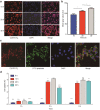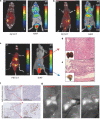Extracellular vesicles-based pre-targeting strategy enables multi-modal imaging of orthotopic colon cancer and image-guided surgery
- PMID: 34022897
- PMCID: PMC8141172
- DOI: 10.1186/s12951-021-00888-3
Extracellular vesicles-based pre-targeting strategy enables multi-modal imaging of orthotopic colon cancer and image-guided surgery
Abstract
Backgroud: Colon cancer contributes to high mortality rates as the result of incomplete resection in tumor surgery. Multimodal imaging can provide preoperative evaluation and intraoperative image-guiding. As biocompatible nanocarriers, extracellular vesicles hold great promise for multimodal imaging. In this study, we aim to synthesized an extracellular vesicles-based nanoprobe to visualize colon cancer with positron-emission tomography/computed tomography (PET/CT) and near-infrared fluorescence (NIRF) imaging, and investigated its utility in image-guided surgery of colon cancer in animal models.
Results: Extracellular vesicles were successfully isolated from adipose-derived stem cells (ADSCs), and their membrane vesicles were observed under TEM. DLS detected that the hydrodynamic diameters of the extracellular vesicles were approximately 140 nm and the zeta potential was - 7.93 ± 0.24 mV. Confocal microscopy showed that extracellular vesicles had a strong binding ability to tumor cells. A click chemistry-based pre-targeting strategy was used to achieve PET imaging in vivo. PET images and the biodistribution results showed that the best pre-targeting time was 20 h, and the best imaging time was 2 h after the injection of 68 Ga-L-NETA-DBCO. The NIRF images showed that the tumor had clear images at all time points after administration of nanoparticles and the Tumor/Muscle ratio peaked at 20 h after injection. Our data also showed that both PET/CT and NIRF imaging clearly visualized the orthotopic colon cancer models, providing preoperative evaluation. Under real-time NIRF imaging, the tumor location and tumor boundary could be clearly observed.
Conclusions: In brief, this novel nanoprobe may be useful for multi-modal imaging of colon cancer and NIRF image-guided surgery. More importantly, this study provides a new possibility for clinical application of extracellular vesicles as nanocarriers.
Keywords: Extracellular vesicles; Image-guided surgery; Multimodal imaging; NIRF; PET/CT.
Conflict of interest statement
The authors declare that there are no conflicts of interest regarding the publication of this paper.
Figures








Similar articles
-
Hydrophobic insertion-based engineering of tumor cell-derived exosomes for SPECT/NIRF imaging of colon cancer.J Nanobiotechnology. 2021 Jan 6;19(1):7. doi: 10.1186/s12951-020-00746-8. J Nanobiotechnology. 2021. PMID: 33407513 Free PMC article.
-
Site-specifically labeled CA19.9-targeted immunoconjugates for the PET, NIRF, and multimodal PET/NIRF imaging of pancreatic cancer.Proc Natl Acad Sci U S A. 2015 Dec 29;112(52):15850-5. doi: 10.1073/pnas.1506542112. Epub 2015 Dec 14. Proc Natl Acad Sci U S A. 2015. PMID: 26668398 Free PMC article.
-
Dual-Modality Image-Guided Surgery of Prostate Cancer with a Radiolabeled Fluorescent Anti-PSMA Monoclonal Antibody.J Nucl Med. 2014 Jun;55(6):995-1001. doi: 10.2967/jnumed.114.138180. Epub 2014 Apr 3. J Nucl Med. 2014. PMID: 24700882
-
Nanoparticles for multimodal in vivo imaging in nanomedicine.Int J Nanomedicine. 2014 Jan 29;9:711-26. doi: 10.2147/IJN.S53717. eCollection 2014. Int J Nanomedicine. 2014. PMID: 24511229 Free PMC article. Review.
-
PSMA-targeting agents for radio- and fluorescence-guided prostate cancer surgery.Theranostics. 2019 Sep 20;9(23):6824-6839. doi: 10.7150/thno.36739. eCollection 2019. Theranostics. 2019. PMID: 31660071 Free PMC article. Review.
Cited by
-
Click Chemistry and Radiochemistry: An Update.Bioconjug Chem. 2023 Nov 15;34(11):1925-1950. doi: 10.1021/acs.bioconjchem.3c00286. Epub 2023 Sep 22. Bioconjug Chem. 2023. PMID: 37737084 Free PMC article. Review.
-
Studying exogenous extracellular vesicle biodistribution by in vivo fluorescence microscopy.Dis Model Mech. 2023 Aug 1;16(8):dmm050074. doi: 10.1242/dmm.050074. Epub 2023 Aug 1. Dis Model Mech. 2023. PMID: 37526034 Free PMC article. Review.
-
Application of Nanoparticles in the Diagnosis and Treatment of Colorectal Cancer.Anticancer Agents Med Chem. 2024;24(18):1305-1326. doi: 10.2174/0118715206323900240807110122. Anticancer Agents Med Chem. 2024. PMID: 39129164 Free PMC article. Review.
-
Control of Physical and Biochemical Parameters Influencing Exogeneous Cargo Protein Association to Extracellular Vesicles Using Lipid Anchors Enables High Loading and Effective Intracellular Delivery.J Extracell Biol. 2025 May 14;4(5):e70048. doi: 10.1002/jex2.70048. eCollection 2025 May. J Extracell Biol. 2025. PMID: 40371218 Free PMC article.
-
Multi-function of adipose-derived stem cells on gut disorder: from bench to bedside.Stem Cell Res Ther. 2025 Aug 20;16(1):444. doi: 10.1186/s13287-025-04549-2. Stem Cell Res Ther. 2025. PMID: 40830985 Free PMC article. Review.
References
MeSH terms
Substances
Grants and funding
LinkOut - more resources
Full Text Sources
Other Literature Sources
Research Materials

